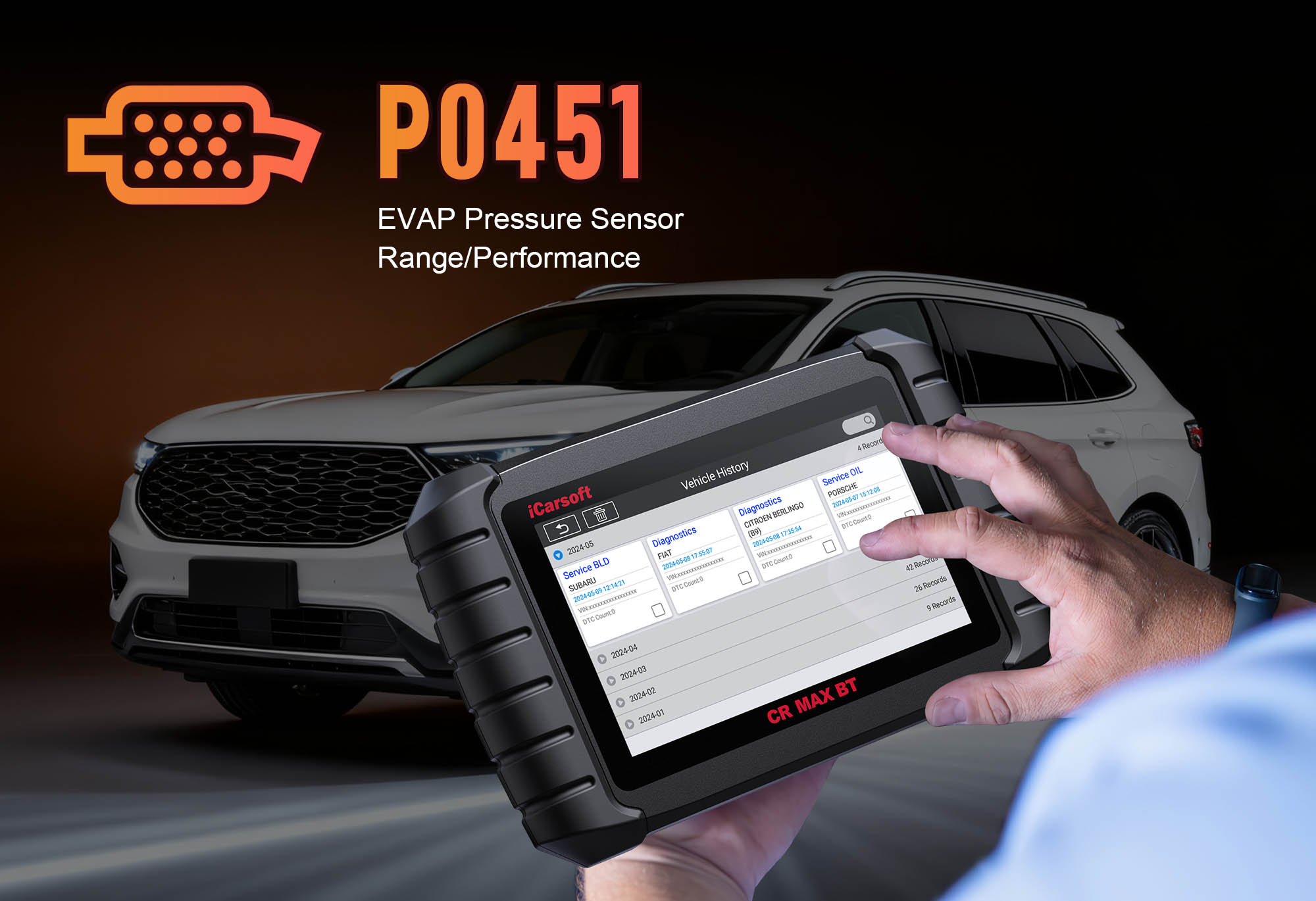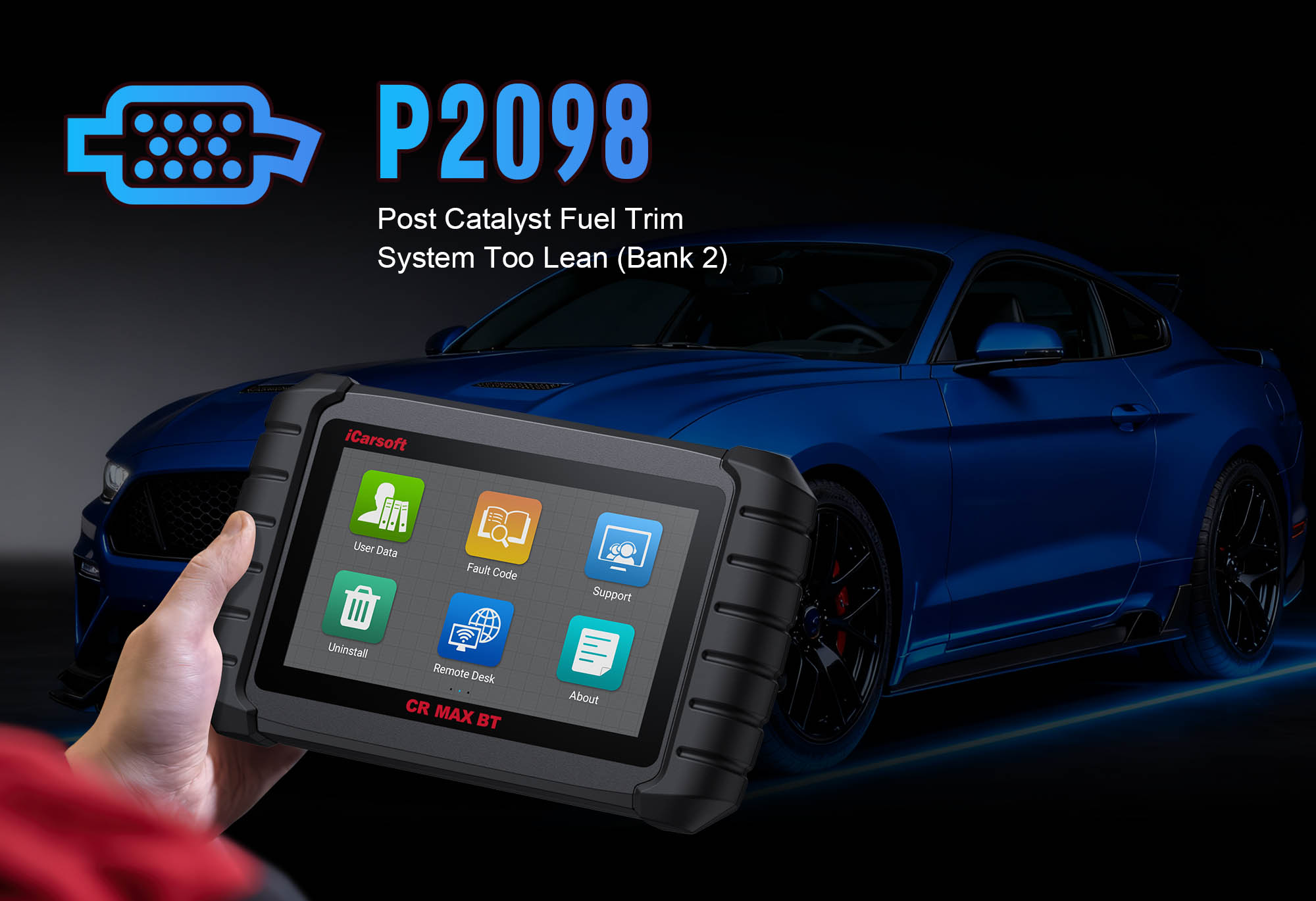Diagnose & Clear P0451 with iCarsoft CR MAX BT
If your vehicle’s check engine light illuminates, you notice a fuel odor near the tank, or it fails an emissions test, a diagnostic scan will likely return P0451. This OBD-II code stands for "Evaporative Emission Control System Pressure Sensor Range/Performance"—a fault targeting the EVAP pressure sensor (also called the fuel tank pressure sensor, FTP sensor).
The EVAP system traps fuel vapors from the tank and routes them to the engine for combustion. When the pressure sensor sends signals outside the manufacturer’s normal range (typically -1.5 psi to +1.5 psi), the ECM can’t detect leaks or regulate vapor flow. This leads to increased emissions, fuel waste, and potential regulatory fines. Basic scanners only flag a "EVAP sensor issue," but the iCarsoft CR MAX BT with specialized diagnostics solves this. Let’s break down how to resolve P0451 step by step.
Understanding P0451: Causes & Key Symptoms
The EVAP pressure sensor is typically mounted on the fuel tank, EVAP canister, or fuel filler neck. It measures pressure/vacuum in the EVAP system: negative pressure (vacuum) during leak tests, positive pressure if the tank is overfilled, and near-atmospheric pressure during normal operation. P0451 triggers when the sensor’s signals are too weak, too strong, or inconsistent—indicating it can’t reliably communicate system pressure.
Key Symptoms of P0451
-
Check Engine Light (CEL): A steady CEL illuminates, and some vehicles display "EVAP System Fault" or "Fuel Tank Pressure Sensor Malfunction" warnings.
-
Fuel Odor: Uncaptured fuel vapors escape the EVAP system, creating a strong gasoline smell near the fuel tank or filler neck.
-
Failed Emissions Test: Excess hydrocarbons (HC) from unregulated vapors cause the vehicle to fail state emissions inspections.
-
Reduced Fuel Economy: A faulty sensor may prevent the ECM from optimizing vapor combustion, dropping mileage by 5–10%.
-
EVAP Leak Warning: Some modern vehicles trigger a separate "EVAP Leak Detected" message, as the sensor can’t distinguish its own fault from system leaks.
Common Causes of P0451
|
Cause
|
Description
|
|
Faulty EVAP Pressure Sensor
|
Internal wear or electronic failure (common after 60,000–100,000 miles) causes erratic or out-of-range pressure readings.
|
|
Damaged Sensor Wiring
|
Frayed wires, rodent chew marks, or corrosion in power/ground/signal lines create resistance or shorts, distorting pressure data.
|
|
Loose/Corroded Connector
|
The sensor’s 3–4 pin connector (near fuel tank/canister) is loose, rusted, or fuel-contaminated—disrupting signal flow.
|
|
EVAP System Leaks
|
Holes in hoses, cracked canisters, or faulty purge/vent valves cause pressure fluctuations misinterpreted as sensor faults.
|
|
Clogged EVAP Lines
|
Debris or fuel residue blocks hoses, creating abnormal pressure buildup that confuses the sensor.
|
|
ECM Malfunction
|
Rarely, the ECM’s internal signal processing circuit fails—misinterpreting normal data as "out of range."
|
Why iCarsoft CR MAX BT Excels at Diagnosing P0451
The CR MAX BT outperforms basic tools with features tailored to EVAP pressure sensor and system diagnostics—critical for resolving P0451 accurately:
Wireless Bluetooth Connectivity
Test sensors near fuel tanks/undercarriages from 30 feet away—no cords hinder access to hard-to-reach components.
Live Pressure & Voltage Tracking
Monitors real-time EVAP pressure (psi) and sensor voltage (0.5V–4.5V), instantly flagging out-of-range values.
EVAP System Leak Test
Runs automated Mode 8 leak detection to distinguish sensor faults from actual EVAP leaks—avoids unnecessary sensor replacement.
AutoVIN Identify
Automatically detects vehicle make, model, and EVAP sensor specs (pressure range, pinouts) in seconds—no manual lookup.
EVAP Component Activation
Uses bi-directional testing to activate purge/vent valves, verifying if pressure changes as expected—rules out valve-related anomalies.
Step-by-Step: Diagnose P0451 with iCarsoft CR MAX BT
-
Safety First & Initial Visual Inspection
1. Relieve fuel pressure: Turn ignition "ON," disconnect fuel pump fuse/relay, start engine until it stalls—turn off ignition.
2. Locate the sensor: Use Component Location > Engine > Emission System > EVAP Pressure Sensor (fuel tank, canister, or filler neck).
3. Inspect for fuel leaks: Check sensor, EVAP hoses, and canister for stains—repair leaks immediately.
4. Check connector: Disconnect, inspect for corrosion/bent pins; clean with contact cleaner and apply dielectric grease.
5. Inspect wiring/hoses: Follow harness to ECM (check frays/heat damage); inspect hoses for cracks/loose connections.
-
Connect the Tool & Confirm P0451
Plug CR MAX BT into OBD-II port, power on, select AutoVIN Identify to retrieve specs. Navigate to Engine > Fault Codes > Read Codes to confirm P0451. Tap Code Details for vehicle-specific insights (e.g., "Ford: EVAP Pressure Expected -1.5 to +1.5 psi, Actual -3.0 psi") and check related codes (P0440, P0442).
-
Monitor Live EVAP Pressure & Sensor Data
1. Reconnect fuel pump fuse/relay, start engine—idle 5 minutes to stabilize.
2. Navigate to Engine > Live Data > EVAP System—monitor two metrics:
- Pressure: Should read ~0 psi (atmospheric) at idle; < -1.5 psi or > +1.5 psi confirms P0451.
- Voltage: Should correspond to pressure (e.g., 2.5V at 0 psi); erratic 0V/5V = sensor/wiring fault.
3. Run leak test: Go to OBDII Functions > Mode 8 > Small Leak Test—"Leak Detected" = system leak, not sensor fault.
-
Test EVAP Pressure Sensor Circuit Integrity
Turn off engine, disconnect sensor connector:
1. Power wire test: Set multimeter to "DC Voltage"—touch power pin + ground. Ignition "ON" = 5V; 0V = blown fuse/broken wire.
2. Ground wire test: Set to "Ohms"—touch ground pin + chassis. Normal = <1 ohm; >5 ohms = poor ground.
3. Signal wire test: Check continuity between signal pin and ECM—no continuity = broken wire.
4. Resistance test: Check power-ground pin resistance; values outside specs (1,000–5,000 ohms) = faulty sensor.
-
Test the Sensor & EVAP System Components
1. Sensor bench test:
- Remove sensor (follow 8–12 ft-lbs torque specs).
- Apply gentle vacuum/pressure with a hand pump—monitor voltage; no smooth change = faulty sensor.
2. Valve activation test:
- Navigate to Special Functions > Engine > EVAP System > Purge/Vent Valve Test.
- Listen for clicking (working valves); no click = stuck valves (cause pressure anomalies).
3. Smoke test (optional): Use a kit or videoscope to detect small EVAP leaks in hard-to-reach hoses.
-
Repair & Clear P0451
- EVAP leaks/clogs: Replace cracked hoses, repair canister; clear clogs with low-pressure compressed air.
- Wiring/connector: Repair frays with heat-shrink; clean fuel-contaminated connectors.
- Faulty sensor: Replace with OEM-equivalent (use Part Lookup—e.g., Bosch 0280142517); torque to specs.
- Faulty valves: Replace stuck purge/vent valves (confirm with activation test).
- ECM malfunction: Consult dealer for reprogramming (last resort—confirm with ECM Communication Test).
Clear code: Go to Engine > Fault Codes > Clear Codes and confirm P0451 is deleted.
-
Validate the Repair
1. Monitor post-repair data: Confirm 0 psi at idle, smooth pressure/voltage changes during driving.
2. Retest leaks: Run Mode 8 Leak Test again—no leaks should be detected.
3. Test drive 30–40 minutes: Include highway driving and refueling (avoid overfilling).
4. Run I/M Readiness Test: Via OBDII Functions to verify EVAP monitor is "Ready" (for emissions compliance).
5. Save report: Use History & Report to document fault, repairs, and post-repair data.
Preventing P0451 Recurrence
-
Regular Sensor Checks: Use Service Reminder to test the EVAP pressure sensor every 40,000 miles—catch early wear.
-
EVAP System Maintenance: Follow Maintenance Schedule to inspect hoses/canisters every 15,000 miles; replace valves every 80,000 miles.
-
Proper Fueling Habits: Avoid overfilling the tank (stop at first pump click) to prevent pressure damage to the sensor.
-
Lifetime Free Updates: Use One-Key Upgrade (Wi-Fi) to add new EVAP diagnostic features as manufacturers release them.
Conclusion
P0451’s EVAP pressure sensor range/performance fault risks fuel waste and regulatory penalties. The iCarsoft CR MAX BT simplifies diagnosis with wireless convenience, live pressure tracking, and EVAP system tests—ensuring you fix the root cause (sensor, leak, or valve issue) instead of guessing.
With global vehicle coverage, 40+ service functions, and lifetime updates, the CR MAX BT is a long-term investment in keeping your vehicle emissions-compliant and efficient. Restore EVAP functionality, eliminate fuel odors, and pass emissions tests—all with one professional-grade tool.





